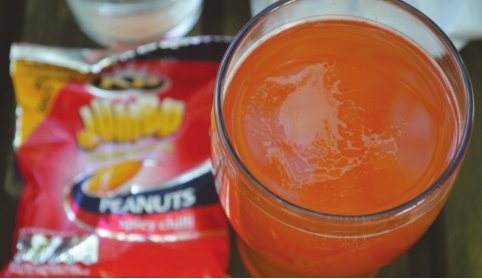 A Tribute to Michigan Hard Cider
A Tribute to Michigan Hard Cider The smell of fermenting apples probably isn’t the scent of the autumn candle sitting on your mantle, and yet, for some, hard cider — the product of those fermenting apples — is particularly alluring. Especially for beer or gluten-intolerant drinkers, hard cider has slowly crept into becoming one of the most popular drinks on draft in bars and pubs across the state, and not just in fall.
Mike Beck, President of Uncle John’s Cider Mill in St. Johns, says that cider is popular because of its deceiving resemblance to beer and its fruity appeal.
“Cider is becoming a viable option as a regular drink,” said Beck. “Wine can sometimes feel a little high-brow, because you’re drinking it out of a stemmed glass. With cider, you can grab a can or go to a pub and get it on draft, and it feels more casual.”
B e c k , who has been making hard cider since 2001 at Uncle John’s, explained that hard cider is popular all year round, as opposed to regular cider, for two reasons. The first is that hard cider can last longer than traditional, non-alcoholic cider due to the alcohol and its packaging. Second is that because, like beer and wine, it can be made in various styles. It ranges from sweet to dry, so no matter the taste preferences, or the time of year, there’s a cider out there for every palate.
“I think that hard cider is often associated with beer because it tends to be packaged like beer — you see it on draft, in cans and six packs. It’s rarer to see wine packaged that way, although, we do sometimes package cider in bottles like wine,” explained Beck.
Because hard cider looks and feels like beer, it probably comes as a surprise to find that hard cider is actually closer in relation to wine than it is to any other alcoholic beverages.
“It’s really no different than making wine.
We press the fruit, make the juice, add the yeast and that’s basically it,” said Beck, noting that the only step aside from those listed is adding the carbonation at the end.
According to Beck, the main difference between making beer and cider, aside from the ingredients involved, is the heating element. With beer, there’s cooking and a sort of science involved. With cider, there’s juice, yeast and a little carbonation.
“When you make cider, the moment the blades cut up the fruit, the process has begun.”
Also like wine, there are specific varieties of apples that are best to use when making hard cider. Beck said that Jonathan, Cortland, McIntosh and the Yellow Delicious varieties can make good hard ciders, but there are also other types that create different styles. Europeanstyle ciders, for example, are typically drier, but can be sweet, too. They are made with European varieties of apples like Pomme Gris or Le Bret.
“There’s barely a beer in Michigan that uses product made in Michigan,” said Beck. “But hard cider is the one thing where you can put a place to that bottle in your hand.”
Beck said that it isn’t just Uncle John’s Cider Mill that utilizes the local product. Other popular hard cideries throughout the state, such as Robinette’s in Grand Rapids, Blake’s Orchard in Armada, Ozone’s Brewhouse in Lansing, Tandem Ciders on the Leelanau Peninsula or Left Foot Charley in Traverse City, are all using local produce.
“It’s more of a natural product; it’s very simple to make and enjoy,” said Beck. “The local aspect is nice, too. If people know where the product comes from and if they’ve been there, and had a good time there or know it, they’re connected to it. People like that connection.”
Support City Pulse - Donate Today!
Comments
No comments on this item Please log in to comment by clicking here